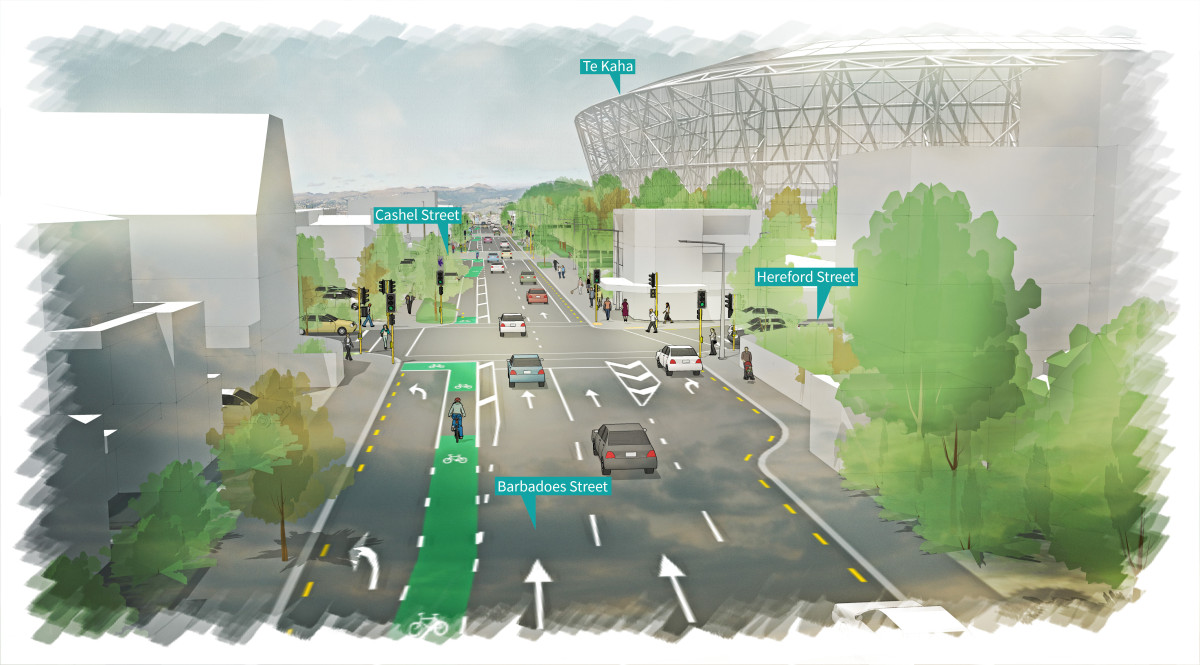We're planning to upgrade the streets surrounding Te Kaha so that they're prepared for the increased activity this area is likely to experience. Have your say on the plans.
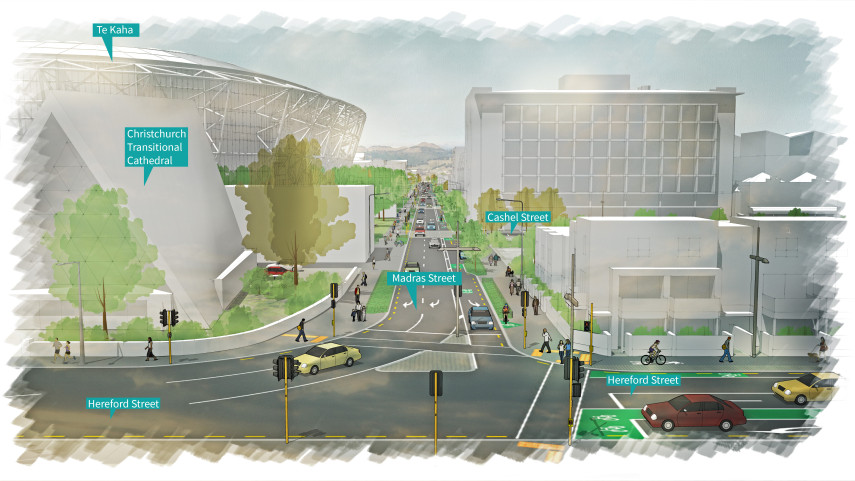
Share this
Consultation has now closed
Consultation on Te Kaha surrounding streets has now closed. People were able to provide feedback from 10 October to 30 November 2022.
You can read their feedback [PDF, 23 MB] and find out how this influenced the hearings panel recommendation to Council(external link). Council's Finance and Performance Committee approved this plan(external link) on 28 June.
The approved plan included a revised, hybrid option for Lichfield Street (between Manchester and Madras).View the plan for Lichfield Street (Manchester to Madras). [PNG, 2.3 MB]
Construction is expected to begin mid-2024.
Christchurch’s south-eastern central city will soon hold the most modern, state-of-the-art, multi-use arena in the southern hemisphere. We want to upgrade the surrounding streets so that they’re prepared for the increased activity this area is likely to experience.
After it opens in 2026, Te Kaha, Canterbury’s Multi-Use Arena will frequently host events that will attract an estimated 15,000 to 20,000 people to this part of the city. It will also host larger, less frequent events, such as international sports fixtures and major concerts. Our experience with Orange Theory stadium and Lancaster Park has taught us that the city needs to be designed in preparation for this.
The planned upgrades to the streets surrounding Te Kaha are designed to reduce the need for expensive area-wide event traffic management plans (EMTPs) at each event. EMTPs will still be required for larger events, such as an international test or a headline music act, but our proposed changes will significantly reduce the need to close certain streets and restrict access around the city.
We also want to create a sense of place and regeneration in the south-east city, where key street upgrades have awaited certainty over Te Kaha’s construction and delivery. The construction of Te Kaha and planned Three Waters (that’s sewerage, stormwater and water supply) work in this area, provide an opportunity to upgrade streets efficiently, and with as little disruption as possible.
These proposed changes are estimated to cost $30 million. This includes improving pedestrian and cycle safety on Fitzgerald and Moorhouse Avenues, improving the connectivity of the intersection of the Manchester-Lichfield-High streets and making the necessary changes to 3 Waters infrastructure.
This entire package of work was approved as part of our Long Term and Annual Plans, and is separate from the $683 million budget approved for the construction of Te Kaha.
Plans have been separated by street, so you can comment on individual sections that are of interest to you.
View the full consultation document. [PDF, 2.2 MB]
We are also making changes to High Street between St Asaph and Tuam. You can view the proposed changes and have your say.(external link)
Once Te Kaha is completed, we anticipate Lichfield Street, with the bus interchange and three car-parking buildings, will be one of the two primary pedestrian gateways to Te Kaha from the west. During larger events, Lichfield Street between Manchester and Madras Streets will be where pedestrians from the west converge as they approach Te Kaha.
Our objective is to create a safe and enjoyable experience for pedestrians moving between the city centre and Te Kaha. The street needs to:
- cope with higher volumes of pedestrians attending regular Te Kaha events without the need for expensive and potentially disruptive event traffic management plans
- make the most of new opportunities presented for nearby businesses
- tie in the new High Street tram line extension
- improve pedestrian safety
- be an attractive place for people to be.
We have developed two options for upgrading Lichfield Street:
- Option 1 - a full street upgrade that maintains local access for traffic, but reallocates more space for mixed uses. This is our preferred option.
- Option 2 - a minimal redesign maintaining two-way vehicular access and some time-restricted parking.
Option 1
Full street upgrade that maintains local access for traffic, but reallocates more space for mixed uses.
This is our preferred option.
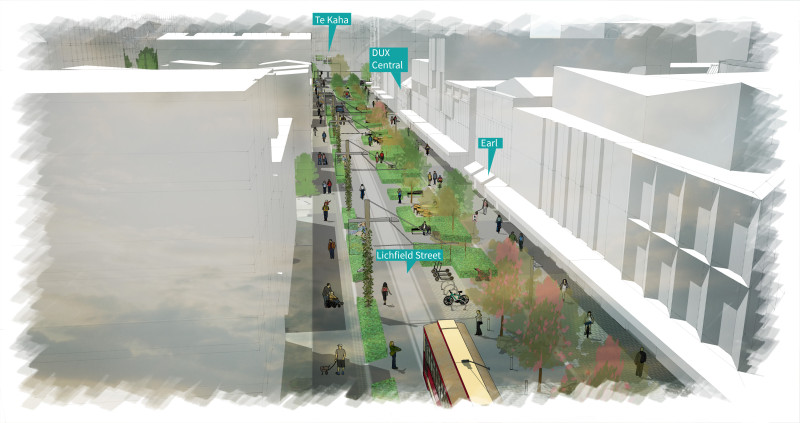
Our preferred option is to redesign the road corridor to create a 10km/h shared-use zone with wider footpaths, passive rain gardens, more space for outdoor dining, and scooter and bike parking.
This section of Lichfield Street would become one-way east-bound, although a slip road from Madras Street to Nurseryman Lane will maintain access to the car-parking building. There will also be loading zones to support the local businesses.
This option meets our objective of creating a desirable pedestrian gateway to the arena and the east of the city, while reducing the need to frequently organise and pay for costly event traffic management. It is envisaged that this new layout would achieve more day-to-day use of the street through pedestrian access and outdoor dining opportunities.
View the plan for option 1 [PDF, 2.1 MB](external link)
| Pros | Cons |
|
Less expensive long-term due to reduced event traffic management and less disruption More attractive streetscape with landscaping, including trees Increased outdoor dining opportunities More cycle and scooter parking More pedestrian and cycle friendly, with speeds reduced to 10 km/h Inclusion of passive rain gardens to reduce water run-off Potential for project to be subsidised by Waka Kotahi The Manchester-Lichfield Street intersection will be upgraded to include diagonal pedestrian crossings when trams are not present |
More expensive in the short-term as upgrades are implemented Removes all existing on-street car parks, while retaining loading zones One-way traffic flow for this section of Lichfield Street changes some local journey route |
Option 2
Minimal redesign maintaining two-way vehicular access and some time-restricted parking
This option is being considered following early feedback from the Central City Business Association. The minimal redesign option provides some opportunities for outdoor dining and an improved street amenity to the south side. It would also retain on-street parking on the northern side.
The status quo of two-way traffic and a 30km/h speed limit would remain.
While this is a slightly cheaper option to build, it’s likely that costly event traffic management plans and street closures would need to be provided more frequently for events at Te Kaha. This means long-term operational costs to keep this current road layout will be higher over the lifetime of Te Kaha, and more disruptive to the area each time an event takes place.
View the plan for option 2 [PDF, 1.8 MB](external link)
| Pros | Cons |
|
Cheaper to build and maintain in the short term Retains 23 of the existing 46 on street car-parking for existing businesses Retains two-way traffic for the entire street Provides a few small areas for outdoor dining opportunities |
No trees and minimal rain gardens to reduce water run-off More expensive to manage and disruptive during most events Less pedestrian and cycling friendly Less cycle and scooter parking No improvement to the crossing at Lichfield/Manchester/High St intersection without compromising the efficiency of the surrounding road network Less beautification |
Budget: up to $3.2m
The main approach to Te Kaha through Te Kaharoa precinct welcomes people from Madras Street at the intersections of Lichfield and Cashel streets. We’ve designed Madras Street, between St Asaph Street and Latimer Square, to ensure large volumes of people can safely and easily access the arena during major events.
We’re expecting high numbers of pedestrians to congregate on Madras Street on event days. To accommodate these crowds and improve safety and security at the arena, we’re planning to widen the footpath to 5.3 metres and remove the 28 car parks on the eastern side of the street.
Most car parks on the west side of Madras Street will be retained, and loading bays for neighbouring businesses and some mobility spaces near the earthquake memorial garden will be included.
We also plan to modify the signalised crossings at the intersections of Tuam, Lichfield and Cashel streets and reduce the Madras Street speed limit to 30km/h, to improve safety for all road users.
Madras Street will be made more attractive with additional trees and landscaping, to blend in with the plans for Te Kaharoa precinct, without compromising its designation as an over-dimension (heavy traffic with oversized loads) route.
Budget: $7.9m
View the plan for Madras Street (St Asaph to Latimer Square) [PDF, 2.2 MB]
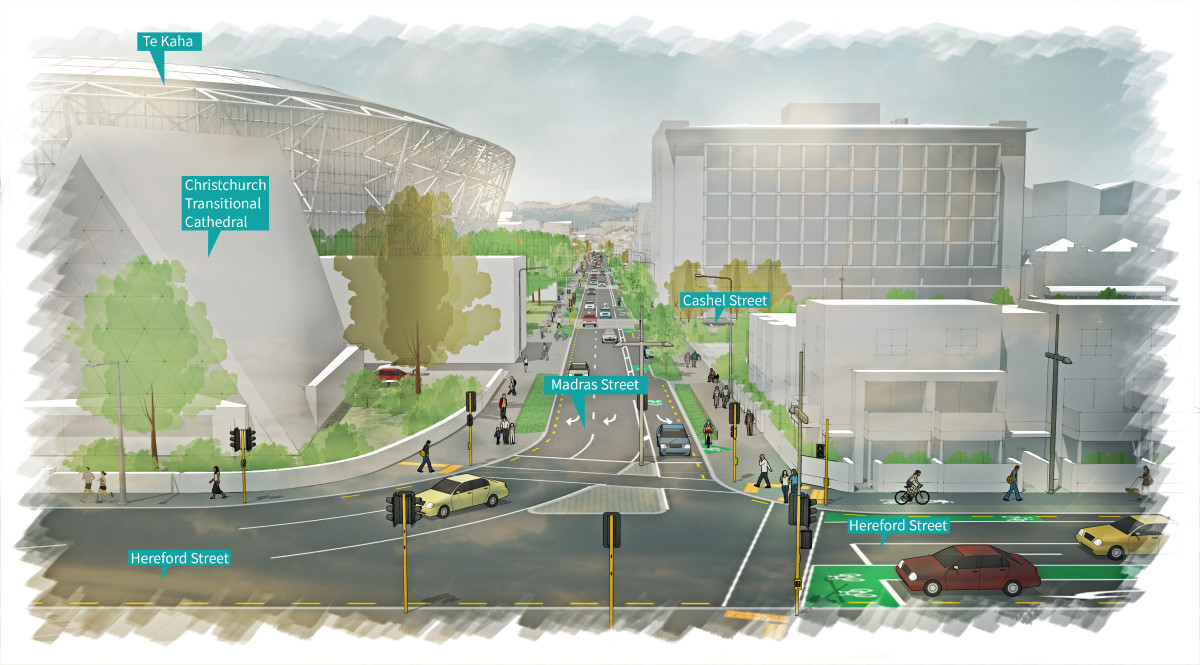
Madras Street is a main thoroughfare into the central city from the southeast. The southern section, between Moorhouse Avenue and St Asaph Street, also provides access to the Ara campus and nearby retail and hospitality businesses.
We’re planning to maintain Madras Street as a key traffic route, but with improved pedestrian and cycling functionality, to address long-standing safety concerns for Ara students crossing this busy road.
We’re planning to add a new, mid-block shared pedestrian and cycle signalised crossing between Countdown and Ara, and reduce the speed limit to 30km/h from Moorhouse Avenue. Both bus stops on this section will also have improved shelters and footpath areas.
We’ve also identified a missing connection for cyclists from the cycleway on St Asaph Street, travelling along Madras Street to Ara, so we’re planning a new, wider shared path on the eastern side of this section of Madras Street.
Parking on the CBD side will be unchanged and the parking on the Ara side changing to P120 to encourage a better turnover of spaces.
Budget: $5.9m
View the plan for Madras Street (Moorhouse to St Asaph) [PDF, 2.1 MB]
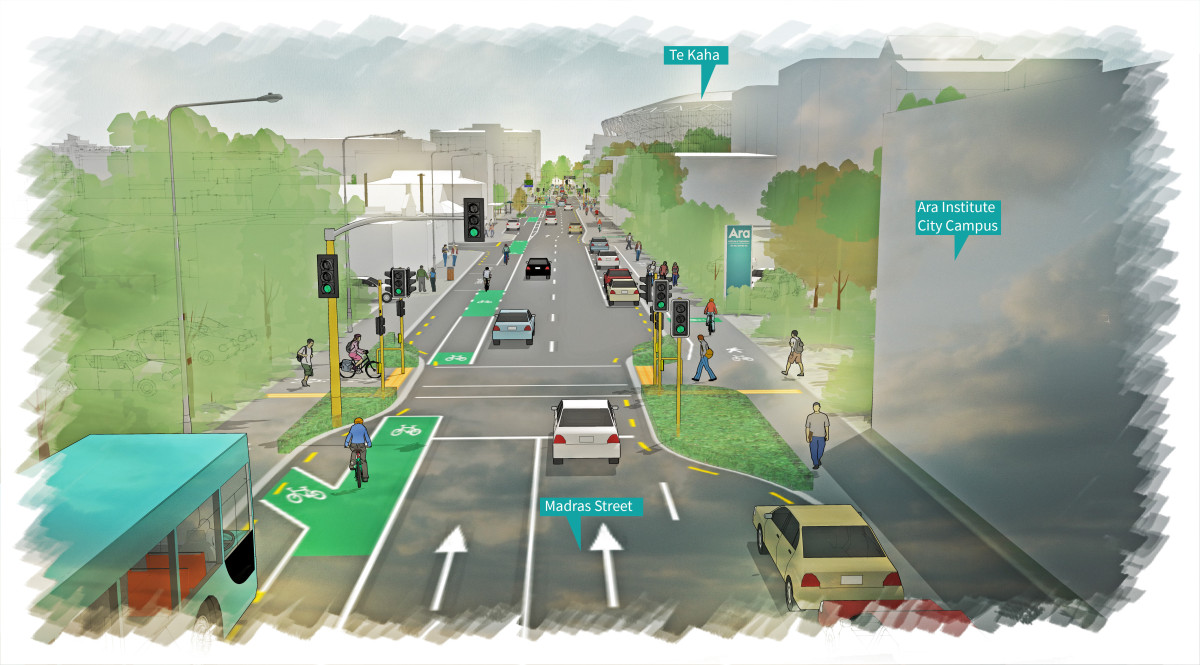
We’re planning a number of changes for Tuam Street, and we’ve broken this into two sections: Madras to Barbadoes Street, and Barbadoes to Fitzgerald Avenue.
Budget: $1.02m
Madras to Barbadoes
This section of Tuam St runs along the southern edge of Te Kaharoa precinct. It’s anticipated that high numbers of pedestrians will use the area before and after events at Te Kaha.
To prepare Tuam Street for large fluctuations in pedestrian numbers, and improve the safety of people visiting the arena, we plan to widen the north side footpath, immediately adjacent to Te Kaha, to 5.8 metres.
To do this we’ll need to remove 15 car-parking spaces on the northern side of this section of Tuam Street and add five parking spaces on the southern side.
We plan to keep the north side public bus stop and parking on the south side of the street. However, these can be modified to better service the needs of neighbouring businesses and destinations, so let us know what you think.
View the plan for this section of Tuam Street [PDF, 2 MB]
Barbadoes to Fitzgerald
We are planning to revert this section of Tuam Street back to a one-way street, to complete the full conversion of Tuam Street to one way eastbound within the central city.
This creates a more intuitive road network across the southern central city, and allows for extra coach parking and layover for events at Te Kaha, as well as more on-street parking on the south side.
It would be delivered in combination with the conversion of Lichfield St between Barbadoes Street and Fitzgerald Avenue to two-way traffic, discussed in a later section.
We’re also planning to improve the pedestrian crossing at the intersection of Tuam Street and Fitzgerald Avenue. This will cater for the larger number of pedestrians we expect to cross Fitzgerald Avenue from the inner eastern suburbs before and after Te Kaha events.
View the plan for this section of Tuam Street [PDF, 1023 KB]

We want to make it as easy as possible for people to enjoy events at Te Kaha, and the eastern section of Lichfield Street between Barbadoes Street and Fitzgerald Avenue will be a crucial piece of the puzzle.
We’re planning to convert this section of Lichfield Street to a two-way street and reduce the speed limit to 30km/h. A speed platform located half-way along is proposed to discourage inappropriate speeds.
During event days (primarily evenings and weekends) this will be the main area for taxis and Ubers to pick up and drop off passengers. At all other times the parking will remain as currently posted. We’re also planning to improve the pedestrian crossing at the intersection of Lichfield Street and Fitzgerald Avenue. This will cater for the larger number of pedestrians we expect to cross Fitzgerald Avenue from the inner eastern suburbs before and after Te Kaha events.
Budget: $1.04m
View the plan for Lichfield Street (Barbadoes to Fitzgerald) [PDF, 1.7 MB]
Te Kaha will have a main entrance on Barbadoes Street, so we expect large numbers of people to congregate on this eastern side of the arena before and after events. Barbadoes Street is a high-volume road, so we need to consider how we can improve safety for all road users, while keeping traffic flowing.
We plan to widen most of the footpath adjacent to Te Kaha, to six metres. To accommodate a wider footpath and increase the venue safety and security, we plan to remove the 29 on-road car-parks on the western side of this section of Barbadoes Street.
We expect more pedestrians to cross from the eastern suburbs, so we’re planning to upgrade the signalised crossings at the intersections with Tuam, Lichfield and Cashel streets.
These upgrades will ensure pedestrians have full protection from turning traffic and reduce improved crossing distances. We’re also planning coach, taxi and Uber drop-off / pick-up zones east of Barbadoes Street.
Parking on the western side of the street will be retained, but may be modified to better service the neighbouring businesses and destinations. We are expecting the area east of Barbadoes Street to diversify and develop over time.
View the plan for Barbadoes Street (Hereford to Tuam) [PDF, 2 MB]
